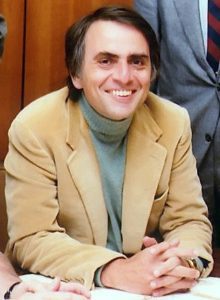

Rich Condit and I had the good fortune to interview astronaut Astro Kate for TWiV 444 at ASM Microbe 2017. Several hours later, she was on stage with Ed Yong. It’s clear why ASM wanted Yong speaking with Rubins: he would draw the biggest possible audience. His science writing is outstanding, and his first book, I Contain Multitudes, sold very well. In fact, Ed was at ASM Microbe to autograph copies of his book.
In 2016 the keynote speaker at ASM Microbe was Bill Gates, for the same reason: to draw a crowd. He was interviewed by Dr. Richard Besser, formerly of ABC News.
I have nothing against Ed Yong; I think he’s doing a great job communicating science. But I think that a scientist should have interviewed Kate Rubins. Why? Because the public views scientists as the most trustworthy spokepersons for science (source: ResearchAmerica). Not bloggers, or journalists, or elected officials, but scientists. And I want scientists to showcase their field, especially in front of other scientists.
What living scientist would have been as popular as Ed Yong at ASM 2017? Surely Steven Hawking, or Neil deGrasse Tyson, who are widely known. But they are not microbiologists. The only life scientist who is as well known as Ed Yong and would draw a big crowd might be Richard Dawkins. Bill Nye is not on this list because he’s an engineer, not a scientist, but he would be a huge draw, bigger than Yong. I would not be surprised to see him at a future ASM Microbe meeting.
We need more celebrity life scientists who are loved by millions, who can explain the nuts and bolts of biology, microbiology, biotechnology, cell biology, and more, and who draw huge crowds. I’m not one of them – my blog and podcasts have many followers, but I would not draw like Ed Yong did at ASM Microbe (our TWiV with astronaut Kate Rubins attracted 50 people). But I believe that my work in science communication shows young scientists that they can appeal to a broad range of science minded people, and perhaps become very popular themselves.
Let the Yong-Rubins keynote be a call to early career life scientists to communicate their science, build their visibility, and become the next Carl Sagan, who reached millions with his television shows and books. It’s not easy, especially combined with a career in research and teaching. But Sagan and others have shown that it can be done. And hopefully you will one day be a big draw at a keynote address!

Pingback: We need celebrity life scientists - Virology
Pingback: We need celebrity life scientists - VETMEDICS
As a scientist dealing with the media quite a bit right now, I’m learning that it’s more difficult than I thought. The motivations of journalsts lean hard toward the expose type of story, and editors demand a particular story ahead of any contacts. This results in fabrications and gross misrepresentation.
There is a pattern to interviews though that is common. In live interviews, the interviewer will prepare some “hardball” questions to try to trip up, shock, or otherwise upset the interviewee. This is both to try to get a rise out of them that could be interesting, and to generate the appearance of credibility. If they are not being adversarial, they will get those out of the way pretty early. If they are really in adversarial mode, they will keep dropping them in, or unload them late. The thing is though, for a scientist, such questions can be unrelated to the science. They can be personal or about opinions you might have voiced on something unrelated.
For print interviews, it can go all sorts of ways. The interview can seem very friendly, but then months later turn into something rather unpleasant. The journalist might contact people you work with out of the blue and yell at them for instance. This is a technique to get a “negative bite” by flustering the person contacted into saying something “interesting”. Push techniques to maneuver ancillary people into saying something they might not even agree with may be used. Taking advantage of social norms in order to keep people talking when they really don’t want to talk and shouldn’t do so can be used.
So it’s a tough problem. With microbes, the most news-genic thing is to beat the drums about death coming for your family. We saw this with the reporting on the NSABB’s censorship of the influenza experiments, and I published a policy paper on that topic. This paper also provides a window into certain aspects of public relations warfare and spying. https://www.omicsonline.org/security-in-a-goldfish-bowl-the-nsabbs-exacerbation-of-the-bioterrorism-threat-2157-2526.S3-013.php?aid=11953 “Security in a Goldfish Bowl: the NSABBs Exacerbation of the Bioterrorism Threat”
The way the press has dealt with microbes is a variant on, “If it bleeds it leads.” Controversy and horseraces also tend to lead and get picked up. Sagan was kind of an anomaly, but he operated in an area of science that was not likely to generate anything but curiosity in the public. His controversy was with religionists of various stripes, and mostly, the press goes along with the side Sagan was on.
So, perhaps these last should be the angles exploited to relate to the press in microbiology? Perhaps finding ways of framing what is said to generate “bleeding headlines” and the appearance of controversy is the way to go. In your case, Dr. R., I would see it this way. In the last contretemps, you could frame your response by saying that the real danger to the public is not in these experiments but in shutting them down. You could paint a picture of how bad things can get without such research, even going a bit afield and using the last Ebola epidemic as an example.
Sometimes it is difficult to get the attention of the press. But once you have it, it tends to be self-perpetuating.